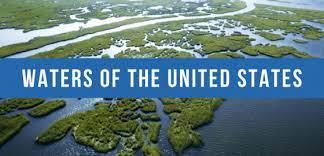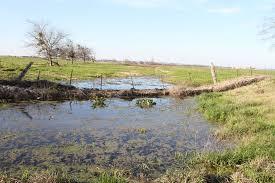 The Waters of the United States (WOTUS) Rule has been subject continuous debate and litigation since 2012 resulting in successive definitions. All of the considerations for and against interpretation of WOTUS have profound implications for land use and the quality of water in our Nation.
The Waters of the United States (WOTUS) Rule has been subject continuous debate and litigation since 2012 resulting in successive definitions. All of the considerations for and against interpretation of WOTUS have profound implications for land use and the quality of water in our Nation.
The following brief timeline is provided to understand the sequence of decisions regarding discharge of pollutants, modification of water courses by dredging or filling and the respective jurisdictions of the Environmental Protection Agency (EPA) and the U.S. Army Corps of Engineers (COE).
- The Clean Water Act of 1972, vested Federal jurisdiction over streams, rivers, wetlands jointly with the EPA and the COE without defining what constitutes "Waters of the U.S."
- In 2006, the U.S. Supreme Court considered whether wetlands that drained ultimately into navigable waterways were considered as WOTUS. The Court was divided 4-1-4 in their Rapanos v. U.S. Army Corp of Engineers decision. Four Justices with an opinion drafted by Associate Justice Antonin Scalia established a standard comprising "a relatively permanent, standing or continuously flowing body of water". Four Justices held that any body of water or potential area where water could accumulate and indirectly affect water quality of lakes and streams could be regarded as WOTUS. Justice Anthony Kennedy held that a wetland could be regarded as a WOTUS if it could connect to navigable waters. This represented the "significant nexus" concept.
- In 2015, the Administration released a broad definition of WOTUS that was challenged on the grounds that it was overly broad and exceeded the scope of authority under the Clean Water Act of 1972.
- In 2020, the Administration published the Navigable Waters Protection Rule (NWPR). This provided a narrow definition restricting the scope of the previous 2015 Rule. This action precipitated lawsuits that persisted until the advent of the current Administration. The Pasqua Waqui tribe in Arizonia challenged the NWPR petitioning for the Rule to be vacated.
- In 2021, the incoming Administration signaled that it would review the entire scope of WOTUS, initiated a list of exceptions and solicited input from the agricultural community, industry and environmental groups. Based on the reality that the EPA under the current Administration would redefine WOTUS, and rectify procedural errors leading to the NWPR, the Rule was vacated with the support of the EPA.
 A legal challenge filed by the Conservation Law Foundation was dismissed following the August 30th 2021, decision by the U.S. District Court for the District of Arizona repealing the NWPR.
A legal challenge filed by the Conservation Law Foundation was dismissed following the August 30th 2021, decision by the U.S. District Court for the District of Arizona repealing the NWPR.- On September 20th 2021, the EPA noted that it had halted implementation of the NWPR and would revert to a pre-2015 regulatory approach until definitions and rulemaking are completed.
It is apparent that WOTUS is now subject to the pre-2015 Rule. Interpretation and permitting will be in accordance with the Clean Water Act until a new Rule is formulated, passes through public comment and is issued. This is certainly not a hold-your-breath moment!